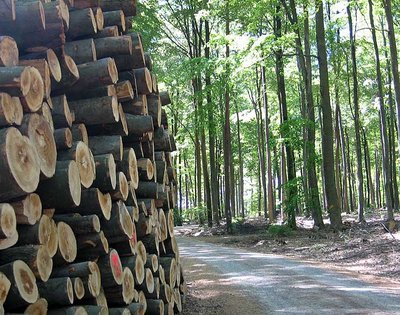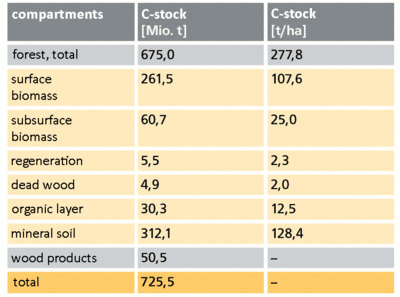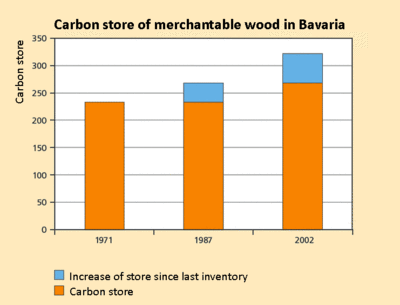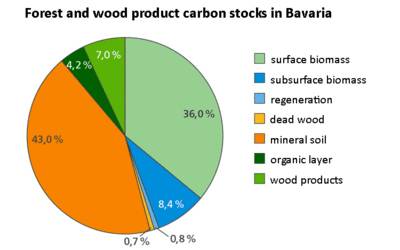The Earth’s forests currently store around 653 billion tonnes of carbon (in all carbon pools, including mineral soil). In the sequestration of one tonne of carbon (C), 3.67 tonnes of carbon dioxide (CO2) are removed from the atmosphere, so this corresponds to approx. 2400 billion tonnes of CO2. The enormous significance of the forests becomes clear if we compare the total carbon storage of the forest with annual global energy-related emissions (approx. 32 billion tonnes CO2 in 2005): forests store more or less the equivalent of the energy-related emissions of 75 years!
In this connection, the areas in the world where the concentration of sequestered carbon is highest are in South America (188 billion tonnes C), particularly in the tropical zones, and in Russia (128 billion tonnes C), although here, the soil plays a very important role as a store (especially the permafrost soils of Siberia).
Public awareness of this special significance of the forests for climate protection is growing, but there is still little knowledge of the extent and scope of the contribution forests make towards climate protection.
Quantifying Bavarian carbon stocks: taking all compartments into account
The forests in Bavaria also bind significant quantities of carbon. To determine the exact quantity of carbon stored, it is crucial to consider all compartments of the forest ecosystem. These are primarily solid timber, regeneration, deadwood and the soil.
The assessment is based on data from the national inventories. The Federal Forest Inventory ("Bundeswaldinventur"/BWI) is the source of data used to determine the quantities stored in the solid timber biomass, regeneration and deadwood. Information from the forest soil condition survey is used to determine the amount of carbon stored in the soil. The sum of carbon in all pools ultimately gives a complete picture for Bavaria of carbon storage in the forest ecosystem. It is possible to trace the development of carbon sequestration over the last few decades using data from past studies.
The forest in Bavaria as a carbon store: currently around 675 million tonnes
Merchantable wood The entire amount of carbon stored in the living dendromass (all trees with a minimum breast height diameter (BHD) of 7 cm), including root biomass, was around 322 million tonnes in the Federal Forest Inventory (BWI) of 2002. This corresponds to a stock of 133 tonnes per hectare. Of this, approx. 81 percent is in the above-ground biomass, and 19 percent is in the below-ground biomass.
Regeneration The amount of carbon stored in the regeneration is estimated to be around 5.5 million tonnes, or 2.3 tonnes per hectare. Unfortunately, the data on regeneration is relatively imprecise. The proportion of the total amount of carbon stored made up by regeneration is however low.
Deadwood
A total of around 4.9 million tonnes of carbon was found to be stored in the deadwood, corresponding to approximately two tonnes per hectare. Almost half of the deadwood is bound in the early stages of decay (44 %).
Soil Bavaria’s soils bind around 141 tonnes of carbon per hectare in soils up to a maximum of 150 cm deep including the forest litter. Calculated for the entire Bavarian forest area, that corresponds to a stock of around 342 million tonnes. This means that the soil carbon stock is in fact slightly higher than the tree biomass stock.
Total carbon stock in forests The total carbon stock of the forests in Bavaria is around 675 million tonnes, or an average of 277.8 tonnes of carbon per hectare. Expressed in terms of units of CO2, this corresponds to a stock of approx. 2480 million tonnes. This means that over the course of time, our forest has sequestered around 28 times the amount of the average annual CO2 emissions.
The development of the carbon stock in forests in Bavaria
The carbon store in managed forests is not static, but part of a constantly dynamic process. If forest utilisation exceeds the growth increment, the forest is a source of carbon. If less timber is harvested than grows, it is a carbon sink.
Whether a forest is a source or a sink ultimately depends on the time period or point in time being considered. Both managed and unmanaged forests will reach a maximum stock of carbon at a certain point in time. From then on, the average stock will be maintained or reduced to a particular level, depending on the objective. Bavaria’s forests have served as carbon sinks in the last few decades, as more carbon has been absorbed by new growth than has been removed from the forest through utilisation (Fig. 1).
The evaluations taken from the forest soil condition survey can only be compared to a limited extent because of methodical differences between the inventories. It can however be established that there has at least been no reduction of the quantities of carbon stored in the soil and litter. For the deadwood there are not as yet any values to be compared, as data on deadwood was not compiled comprehensively until the second federal forest inventory (BWI2).
Timber products as carbon stores
Wood products have a positive effect on the climate in that they lengthen the period of storage of the carbon that was locked in the forest by the duration of the specific service life of the product. However, the substitution effects of the timber (material and energy substitution) play a much more significant role in the long term (see box). Taking all product segments together, timber products in use in Bavaria store approx. 50.5 million tonnes of carbon.
If we add the timber products to the forest carbon store, the total carbon store amounts to 725.5 million tonnes. At seven per cent of the total carbon store, the timber products are certainly significant, but the direct storage of carbon in the forest plays a considerably more important role (Fig. 2). On the other hand, the wood products pool is likely to be the one that is easiest to influence in the near future.
Cascade utilisation as a future model
Because of the high stocks of timber, and not least also because of the high demand for wood from our native forests, it is likely that the sink function of the forests in Bavaria will reach its limits in the foreseeable future. It is therefore all the more important to include the wood products in the overall evaluation, and that we also continue to deal efficiently with wood as a resource in future. Cascade utilisation is already often called for and should be used as a tool to help us to do so.




